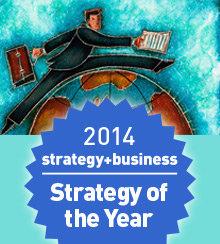The Internet of Things Wins s+b’s 2014 Strategy of the Year
The linking of billions of devices through the Web has scaled the heights of strategy fashion.
What was the “it” strategy of 2014? In my last post I asked for your nominations, and I received many great candidates. This comes as no surprise: Ever since strategy became the word business leaders use to give something great importance, there’s been no shortage of “next big things.” And the past year was no exception. Big data strategy continued the streak of popularity that won it s+b’s 2013 Strategy of the Year. “Agile strategy” entered into the business vocabulary from its roots in software development. And I increasingly heard “What’s your Uber strategy?” as the so-called sharing economy gained traction, and “What’s your cloud strategy?” as more companies outsourced their computing power and digital data storage to third-party suppliers.
But there can be only one winner, and s+b’s pick for the 2014 Strategy of the Year is Internet of Things (IoT) strategy. Two standout runners-up, however, are worth noting. One is “corporate trust strategy,” which strikes me as being the next generation of corporate social responsibility, and which raises some interesting questions. Can having high trust equity give a company an advantage in buying and owning businesses (think Berkshire Hathaway)? Can trust—building it, protecting it, and exploiting it—be a distinctive capability that enables a business to win in its target market? How much does trust enter into the equation, consciously or not, when customers choose to do business with you or your competitors? Although I struggle to see the benefit in having a separate strategy for corporate trust, I can certainly see the benefits of deliberately considering its role in a company’s corporate and business strategies.
The other runner-up is “full stack strategy.” I have to admit, this was a new one for me. From what I understand, it’s the logical—if not hyperbolic —extension of venture capitalist Marc Andreesen’s thesis of “Why Software Is Eating the World”: a Silicon Valley conception of strategy, particularly for startups, to build a complete, end-to-end business around a new technology rather than a “partial stack strategy” to sell or license it to an existing company. Businesses such as Uber, Nest, and Tesla are highly visible examples. But although it seems to be all the rage in Silicon Valley, I have yet to see it emerge in mainstream industry. Perhaps in another year or two that will change.
That brings me back to the winner: IoT strategy. You know something has hit it big when Michael Porter picks it up, as he did with his recent Harvard Business Review cover story. Now you see the IoT everywhere. After “dot-com” and “social,” it’s the third great business fashion spawned by the Internet. It took center stage at the recent International Consumer Electronics Show—the Los Angeles Times reported that there were 900 IoT exhibitors—and was the focus of the keynote address by Samsung CEO Boo-Keun Yoon. It has risen to prominence for good reasons: My Strategy & colleague Frank Burkitt estimated in this magazine that 50 billion devices around the world will be connected to the Internet by 2020, producing “a transformative shift for the economy, similar to the introduction of the PC itself.”
Yes, the IoT will change the products and services bought by people and businesses, and the ways in which they are made, marketed, sold, distributed, and consumed. It will bring enormous opportunities and threats to most businesses, and spawn many new businesses while undermining old ones. But as with all new phenomena to hit the business world, it will not change what strategy is all about.
As with all new phenomena to hit the business world, IoT will not change what “strategy” is all about.
In previous posts, I have discussed the five fundamental questions that form the backbone of every company’s corporate and business strategies:
· What business or businesses should you be in?
· How do you add value to your businesses?
· Who are the target customers for your businesses?
· What are your value propositions to those target customers?
· What capabilities differentiate your businesses and their value propositions?
The Internet of Things might change your answers, but it won’t change the questions themselves. The electricity grid and telephone network revolutionized business at the start of the 20th century. The moving assembly line did much the same in the early 1900s, as did computing technology in the late 1900s. Yet today you don’t hear companies talk about their electricity, telephone, moving assembly line, or computing strategies. In 50 years, you won’t hear them talk about their IoT strategies, either.
Although the IoT is an increasingly important consideration, developing an IoT strategy isn’t the way to get the most out of the IoT phenomenon. Companies are already wasting enormous amounts of time, money, and opportunity by developing big data strategies, instead of asking how big data changes their corporate and business strategies and which big data capabilities they need in order to implement their strategies successfully. They did the same with quality in the 1980s, reengineering in the ’90s, dot-com in the last decade, and social in recent years.
Instead, consider how the IoT changes your corporate and business strategies: How will it change what businesses you are in? How will it change the way you add value to your businesses or the target customer for any of your businesses? How will it change your suppliers and customers or their suppliers and customers? Does it change the value proposition to your target customer? Does it make obsolete or out-of-date any of the capabilities that differentiate your company and its individual businesses?
Put simply, don’t ask, “What is our IoT strategy?” Ask, “What holes and opportunities does the IoT open up for the corporate and business strategies we already have?”






